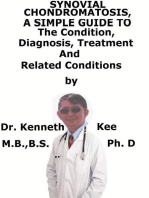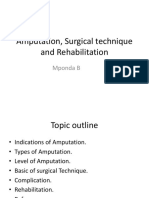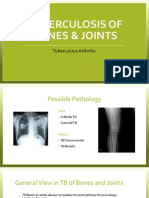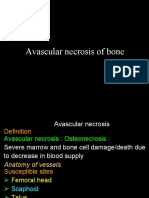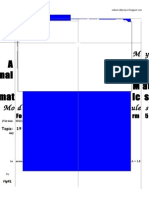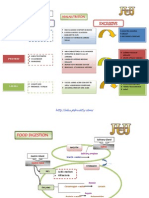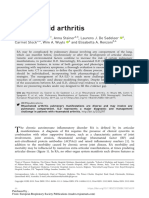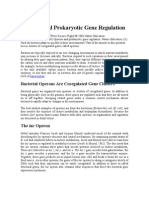Osteoarthritis & Rheumatoid Arthritis
Osteoarthritis & Rheumatoid Arthritis
Uploaded by
Saya MenangCopyright:
Available Formats
Osteoarthritis & Rheumatoid Arthritis
Osteoarthritis & Rheumatoid Arthritis
Uploaded by
Saya MenangOriginal Description:
Original Title
Copyright
Available Formats
Share this document
Did you find this document useful?
Is this content inappropriate?
Copyright:
Available Formats
Osteoarthritis & Rheumatoid Arthritis
Osteoarthritis & Rheumatoid Arthritis
Uploaded by
Saya MenangCopyright:
Available Formats
Osteoarthritis &
Rheumatoid Arthritis
Iwin Soossay Sathianathan
1003C79006
Dr.Alireza
Orthopaedics Posting
Taylors University
Contents
Definition
Epidemiology
Risk factors
Causes
Pathophysiology
Clinical presentation
Complications
Differential diagnosis
Investigation
Management
Definition
Osteoarthritis is a chronic joint disorder in which there is progressive
softening and disintegration of articular cartilage accompanied by
new growth of cartilage and bone at the joint margins
(osteophytes) and capsular fibrosis.
Epidemiology
Most common age group is the elderly.
Females more commonly affected than males
Incidence rates increase with age
Classification of OA
OA
Primary
OA
Secondary
OA
Primary OA
More common than secondary OA
Cause Unknown
Common-in elders where there is no previous pathology.
Its mainly due to wear and tear changes occuring in old
ages mainly in weight bearing joints.
Secondary OA
Due to a predisposing cause such as:
Injury to the joint
Previous infection
Deformity
Obesity
Hyperthyroidism
Risk factors
Modifiable
Obesity
Trauma
Occupation(hard labor)
Non-Modifiable
Gender-females at increased risk
Age
Genetics
Race
Etiology
Disparity between stress applied to articular cartilage
and the ability of the cartilage to withstand that stress.
Weakening of articular cartilage
Possibly due to genetic defects in type II collagen
Increased mechanical stress in some part of the articular
surface
Excessive impact loading
Pathophysiology
In a normal joint, the loading forces are evenly distributed.
Cartilage damage results from increased stress on some part of articular surface.
Cartilage damage occurs & softening (chondromalacia)
Preceding inflammatory disorder
Progressive disintegration of cartilage
Bone is being exposed
Peripheral cartilage (unstressed) proliferate & ossifies
Producing bony growth (osteophyte)
Joint capsule thickening & fibrosis
Cardinal Features of the OA Pathophysiology
Progressive cartilage destruction
Subarticular cyst formation
Sclerosis of the surrounding bone
Osteophyte formation
Capsular fibrosis
Structural changes with Osteoarthritis
Early
Cartilage softens, pits, frays
Progressive
Cartilage thinner, bone ends hypertrophy,
bone spurs develop and fissures form
Advanced
Secondary inflammation of synovial
membrane; tissue and cartilage destruction; late
ankylosis
Normal Knee
structure
Moderately
advanced
osteoarthritis
Advanced
osteoarthritis
Clinical Features of OA
Pain
Stiffness
Muscle
spasm
Restricted
movement
Deformity
Muscle
weakness or
wasting
Joint
enlargement
and
instability
Symptoms
Pain
Starts insidiously & increase slowly over months and years
Continous pain which can be very severe at times
Maybe referred to a distant site
Aggravated: exertion
Relieved: rest
Late stage: pain in bed at night even during rest
Swelling -intermittent: suggest effusion
-continuous: capsular thickening/ large osteophytes
Minimal morning stiffness (<20 min) and after inactivity (gelling)
Loss of function-such as difficult climb stairs, restriction of walking
distance, progressive inability to perform everyday task
Signs(P/E)
Look
Antalgic gait or assumption of a posture that allows minimum weight on a
painful limb or joint
Muscle wasting
Varus deformity
Feel
Palpable bony enlargement
Joint line tenderness
Mild joint effusion
Move
Limited range of motion
Joint tenderness on passive range of motion
Joint crepitus on motion (audible or palpable)
Limb shortening
Varus Deformity
A patient with typical OA
of the knees. In the normal
standing posture there is a
mild varus angulation of
the knee joints due to
symmetrical OA of the
medial tibiofemoral
compartments.
Knee joint effusion
Osteoarthritis of the DIP joints.
This patient has the typical
clinical findings of advanced
OA of the DIP joints, including
large firm swellings
(Heberdens nodes), some of
which are tender and red due
to associated inflammation of
the periarticular tissues as well
as the joint.
Unstable distal
interphalangeal joints in
OA. The examiner is able
to push the joint from side
to side due to gross
instability, a common
finding in late
interphalangeal joint OA.
Differential diagnosis
Avascular necrosis(Osteonecrosis)
Inflammatory arthropathies
Polyarthritis of the finger
Rheumatoid arthritis
Diffuse idiopathic skeletal hyperostosis (DISH)
Complications
Capsular herniation
OA of the knee with a marked effusion and herniation of the
posterior capsule(Bakers cyst)
Loose bodies
Cartilage & bone fragments produce loose bodies, resulting in
episodes of locking.
Rotator cuff dysfunction
OA of acromioclavicular joints may cause rotator cuff
impingement, tendinitis or cuff tears
Investigations
Laboratory
Blood tests: Normal,
WBC increased if infection (secondary OA)
CRP and ESR: indicate any infection (secondary OA)
Renal Profile: Normal
Radiological
X-Ray
X-Ray
X-rays illustrating the
Cardinal Signs
Narrowing of the joint space
Sclerosis of the subchondral
bone
Cysts close to the articular
surface
Osteophytes at the margins of
the joint
Remodelling of bone ends on
either side of the joint
Late features: joint
displacement and bone
destruction
*Important criteria of taking a
X-Ray of an OA patient is???
Kellgren & Lawrence System
The Kellgren & Lawrence system is method of
classifying the severity of knee osteoarthritis. This is
classified into five grades:
grade 0 - no radiographic features of OA are present
grade 1 - doubtful joint space narrowing (JSN) & possible osteophytic lipping
grade 2 - the presence of definite osteophytes and possible JSN on
anteroposterior weight-bearing radiograph.
grade 3 - multiple osteophytes, definite JSN, sclerosis, possible bony deformity
grade 4 - large osteophytes, marked JSN, severe sclerosis & definitely bony
deformity
Management
Depends on the joint involved, the stage of disorder, the
severity of the symptoms, the age of the patient and
his/her functional needs.
There are two branch
-Conservative
-Operative
Conservative emphasis on 1.Relieving pain
2.Reducing load
3.Improving mobility
Early
Analgesic medication (PCM, NSAIDS)
Load reduction
protecting the joint from excessive load may slow down the rate of cartilage loss
effective in relieving pain
Physical therapy
Maintaining joint mobility
Improving muscle strength
Intermediate
Joint debridement(removing osteophytes, cartilage tags & loose bodies)
May be done either by arthroscopy or by open operation
Late
Three basic operations:
Realignment osteotomy
Arthroplasty (total joint replacement)
Arthrodesis
Definition
A chronic disease characterized by the inflammation of the lining of
the joints, which is called the synovium.
Known as an autoimmune disease because the bodys immune
system attacks the joint lining.
Epidemiology
Affects about 3% of the population
Women is more at risk than men, 3:1
Etiology
The exact cause of RA is unknown.
Suspected causes are:
Bacterial Infection
Genetic Marker
Stress
Viral Infection
Pathophysiology
All tissues throughout the body is affected, brunt attack falls on synovium.
3 stages of progression of the disease.
Stage 1: Synovitis (Synovial membrane becomes inflamed and thickened,
giving rise to a cell rich effusion. Although painful and swollen, the joints and
tendons are still intact an dthe disorder is reversible)
Stage 2: Destruction(Persistent inflammation causes tissue destruction.
Articular cartilage is eroded and tendon fibres may rupture)
Stage 3: Deformity(The combination of articular destruction, capsular
strecthing and tendon rupture leads to progressive instability and deformity)
Diagnostic Criteria
Morning stiffness
Arthritis of 3 or more joints
Arthritis of hand joints
Symmetric arthritis
Rheumatoid nodules
Serum rheumatoid factor
Radiographic changes
*A person shall be said to have rheumatoid arthritis if he or she
has satisfied 4 of 7 criteria, with criteria 1-4 present for at least
6 weeks
Clinical Features of RA
Symptoms
Fatigue
Swelling on proximal finger joints and wrist
Stiffness, especially in early morning and after sitting
a long period of time
Low grade fever
Weakness
Muscle pain and pain with prolonged sitting
Symetrical, affects joints on both sides of the body
Limited joints movements
Signs
Rheumatoid nodules
Deformity of joints over time
Hallux valgus
Hammer toe
Bouttoinniere thumb
Subcutaneous nodules (disappear
and appear without warning)
Rheumatoid Arthritis: PIP Swelling
Swelling is confined to the area
of the joint capsule
Synovial thickening feels like a
firm sponge
Rheumatoid Arthritis:
Ulnar Deviation and MCP Swelling
Prominent ulnar deviation in the
right hand
MCP and PIP swelling in both
hands
Synovitis of left wrist
Differential diagnosis
Reiters Disease
Polyarticular gout
Polyarticular osteoarthritis
Polymyalgia rheumatica
Seronegative polyarthritis
Complications
Infection
At risk for septic arthritis
Tendon Rupture
Nodular infiltration may cause this
Joint Rupture
Joint lining ruptures and synovial contents spill into soft tissues
Secondary Osteoarthritis
Articular cartligae erosion may leave joint so damaged, end
stage of disease will be similar to advanced osteoarthritis
Investigations
Laboratory
Blood tests: Normal,
WBC increased if infection
CRP and ESR: indicate any infection
Renal Profile: Normal
Serological Test: Rheumatoid Factor (+)
Radiological
X-Ray
X-Ray
Features of X-Ray
Stage 1 - Only soft tissue swelling and periarticular
osteoporosis
Stage 2 - Narrowing of joint space and marginal bony
erosion, especially around wrists and proximal joints of
hands and feets
Stage 3 Articular destruction and joint deformity
Management
There is no cure for RA.
Patient needs reassurance and management can be
done by alleviating symptoms and delay progression.
Principles of treatment is to:
1. Stop the synovitis
2. Keep the joints moving
3. Prevent deformity
4. Reconstruct
5. Rehabilitate
X-ray Features of Osteoarthritis (LOSS)
Loss of joint space
Osteophytes
Subchondral sclerosis
Subchondral cysts
X-ray Features of Rheumatoid Arthritis (LESS)
Loss of joint space
Erosions
Soft tissue Swelling
Soft bones (osteopenia)
References
Apleys Concise System of Orthopaedics and Fractures.
3
rd
ed.
Apleys System of Orthopaedics and Fractures. 9
th
ed.
Ortho Bullets
Joint Protection: Dos and Donts
Thank You
You might also like
- Galactic History MU LEMURIA pt3Document7 pagesGalactic History MU LEMURIA pt3Iu Iiano100% (1)
- Amyotrophic Lateral SclerosisDocument24 pagesAmyotrophic Lateral SclerosisJeanessa Delantar QuilisadioNo ratings yet
- Cotton OsteotomyDocument16 pagesCotton OsteotomybaoNo ratings yet
- RN ExamDocument75 pagesRN ExamKirsten SabanalNo ratings yet
- Compartment Syndrome, A Simple Guide To The Condition, Diagnosis, Treatment And Related ConditionsFrom EverandCompartment Syndrome, A Simple Guide To The Condition, Diagnosis, Treatment And Related ConditionsNo ratings yet
- Paget Disease of Bone, A Simple Guide to the Condition, Treatment and Related DiseasesFrom EverandPaget Disease of Bone, A Simple Guide to the Condition, Treatment and Related DiseasesNo ratings yet
- Synovial Chondromatosis, A Simple Guide To The Condition, Diagnosis, Treatment And Related ConditionsFrom EverandSynovial Chondromatosis, A Simple Guide To The Condition, Diagnosis, Treatment And Related ConditionsNo ratings yet
- Avascular Necrosis, A Simple Guide To The Condition, Diagnosis, Treatment And Related ConditionsFrom EverandAvascular Necrosis, A Simple Guide To The Condition, Diagnosis, Treatment And Related ConditionsRating: 4 out of 5 stars4/5 (2)
- The Thoracic Outlet Syndrome, A Simple Guide To The Condition, Diagnosis, Treatment And Related ConditionsFrom EverandThe Thoracic Outlet Syndrome, A Simple Guide To The Condition, Diagnosis, Treatment And Related ConditionsNo ratings yet
- Osteochondritis Dissecans: Vivek PandeyDocument25 pagesOsteochondritis Dissecans: Vivek PandeyRabin DasNo ratings yet
- RS2480 Amputation 2018Document49 pagesRS2480 Amputation 2018Hung Sarah100% (1)
- Common Spinal Disorders Explained PDFDocument2 pagesCommon Spinal Disorders Explained PDFTamekaNo ratings yet
- Tuberculosis of The HipDocument33 pagesTuberculosis of The Hipmuhammad bayu wicaksonoNo ratings yet
- SPONDYLOLISTHESISDocument46 pagesSPONDYLOLISTHESISJino Alex100% (1)
- Effect of Age On Task Complexity, Exercise and Ambulation: Group 8Document17 pagesEffect of Age On Task Complexity, Exercise and Ambulation: Group 8PreciousShaizNo ratings yet
- Tendon Transfers and Upper Limb Disorders: Aws KhanfarDocument41 pagesTendon Transfers and Upper Limb Disorders: Aws KhanfarRaghu Nadh100% (1)
- Lumbar Disc HerniationDocument29 pagesLumbar Disc HerniationFAISAL AHMAD YUSUFNo ratings yet
- Amputation: Sites of Amputation: UEDocument6 pagesAmputation: Sites of Amputation: UEChristine PilarNo ratings yet
- Roles of Rehab in Wound CareDocument83 pagesRoles of Rehab in Wound Careanon_416792419No ratings yet
- Medical Rehabilitation in Compression FractureDocument32 pagesMedical Rehabilitation in Compression FracturegloriaNo ratings yet
- Clinical Orthopaedics: August 2011Document15 pagesClinical Orthopaedics: August 2011Tarun Singh SinghNo ratings yet
- Supracondylar Humerus FractureDocument20 pagesSupracondylar Humerus FractureMusyawarah MelalaNo ratings yet
- Lower Extremity Special TestsDocument16 pagesLower Extremity Special TestsAlyssa BatasNo ratings yet
- Amputation, Surgery and RehabilitationDocument46 pagesAmputation, Surgery and RehabilitationPatrick WandellahNo ratings yet
- CRANIOVETEBRALJUNCTIONDocument130 pagesCRANIOVETEBRALJUNCTIONdrarunrao100% (1)
- Tabes DorsalisDocument36 pagesTabes DorsalisEric ChristianNo ratings yet
- Leg Ankle Orthopaedic Conditions FinalDocument26 pagesLeg Ankle Orthopaedic Conditions Finalangel bolfriNo ratings yet
- Musculoskeletal Cases For Finals: DR Alastair Brown ST1 Neurosurgery CXHDocument38 pagesMusculoskeletal Cases For Finals: DR Alastair Brown ST1 Neurosurgery CXHAravind RaviNo ratings yet
- Cervical OrthosisDocument39 pagesCervical Orthosisshubham raulNo ratings yet
- Writing Knee OsteoarthritisDocument58 pagesWriting Knee OsteoarthritisHanani KamaludinNo ratings yet
- CTEVDocument27 pagesCTEVJevisco LauNo ratings yet
- Bones and Joints TBDocument19 pagesBones and Joints TBmichaelcylNo ratings yet
- Lecture 11aDocument40 pagesLecture 11aElliya Rosyida67% (3)
- Fracture ManagementDocument21 pagesFracture ManagementPatrickk WandererNo ratings yet
- Tendon Transfers: by DR Krishna BhattDocument89 pagesTendon Transfers: by DR Krishna Bhattvenkata ramakrishnaiahNo ratings yet
- Avn and Perthes DiseaseDocument29 pagesAvn and Perthes DiseaseRoopa Lexmy MuniandyNo ratings yet
- Prepared By: Floriza P. de Leon, PTRPDocument10 pagesPrepared By: Floriza P. de Leon, PTRPFloriza de Leon100% (1)
- SC - Fracture ZMHDocument51 pagesSC - Fracture ZMHMis Strom100% (1)
- Pathomechanics of Wrist and HandDocument16 pagesPathomechanics of Wrist and Handsonali tushamerNo ratings yet
- Fractures - Diagnosis and ManagementDocument28 pagesFractures - Diagnosis and ManagementdrthanallaNo ratings yet
- Tests in Pediatric NeurologyDocument23 pagesTests in Pediatric NeurologyWartuhi GrigoryanNo ratings yet
- Periarthritis Shoulder By: DR - Sindhu.MPT (Ortho)Document39 pagesPeriarthritis Shoulder By: DR - Sindhu.MPT (Ortho)Michael Selvaraj100% (1)
- Gait Biomechanics 1Document43 pagesGait Biomechanics 1Dibyendunarayan Bid50% (2)
- Adverse Neural Tension 2012Document7 pagesAdverse Neural Tension 2012ramesh2007-mptNo ratings yet
- Spinal Range of MovementDocument38 pagesSpinal Range of MovementUneeb Ali ShahNo ratings yet
- Lower Limb OrthosisDocument12 pagesLower Limb Orthosismm3370350No ratings yet
- Intervertebral Disc ReplacementsDocument20 pagesIntervertebral Disc ReplacementsHugo NascimentoNo ratings yet
- Cervical Spine InjuriesDocument11 pagesCervical Spine InjuriesPrakarsa Adi Daya NusantaraNo ratings yet
- Mptregulations 2010Document81 pagesMptregulations 2010jayababuNo ratings yet
- Types of Physiotherapy TreatmentsDocument2 pagesTypes of Physiotherapy TreatmentsenadNo ratings yet
- MCQ PartDocument6 pagesMCQ PartUsama El BazNo ratings yet
- Spinal Cord InjuryDocument27 pagesSpinal Cord InjuryHanis Malek100% (2)
- ACL ReconstructionDocument21 pagesACL ReconstructionMeet ShahNo ratings yet
- AtaxiaDocument8 pagesAtaxiaTony WilliamsNo ratings yet
- Introductio To OrthoticsDocument8 pagesIntroductio To OrthoticsGopi Krishnan100% (1)
- Soft Tissue InjuryDocument2 pagesSoft Tissue InjuryThiruNo ratings yet
- Total Hip ReplacementDocument13 pagesTotal Hip ReplacementrezkyagustineNo ratings yet
- Erbs PalsyDocument9 pagesErbs PalsyVatsalVermaNo ratings yet
- FroDocument5 pagesFrochinmayghaisasNo ratings yet
- Spinal Cord Injuries: Gabriel C. Tender, MDDocument49 pagesSpinal Cord Injuries: Gabriel C. Tender, MDCathyCarltonNo ratings yet
- TORTICOLISDocument40 pagesTORTICOLISwanni wuyamNo ratings yet
- Septic Arthritis UpgradedDocument47 pagesSeptic Arthritis UpgradedVishva Randhara AllesNo ratings yet
- Bab 02 Sebatian Karbon Edisi BM Bi 2017 JPWN Update 18-1-17Document70 pagesBab 02 Sebatian Karbon Edisi BM Bi 2017 JPWN Update 18-1-17Saya MenangNo ratings yet
- Physics PEKA Scoring Check ListDocument2 pagesPhysics PEKA Scoring Check ListSaya MenangNo ratings yet
- Cerebellar ExaminationDocument1 pageCerebellar ExaminationSaya MenangNo ratings yet
- Basketball Students Attendance List 2017 Dates Class 9/1 16/1 23/1 6/2 13/2 20/2 27/2 6/3 13/3 27/3 3/4 10/4 17/4 24/4Document2 pagesBasketball Students Attendance List 2017 Dates Class 9/1 16/1 23/1 6/2 13/2 20/2 27/2 6/3 13/3 27/3 3/4 10/4 17/4 24/4Saya MenangNo ratings yet
- Trial Terengganu SPM 2013 PHYSICS Ques - Scheme All PaperDocument0 pagesTrial Terengganu SPM 2013 PHYSICS Ques - Scheme All PaperCikgu Faizal67% (3)
- Rates of Reaction TestDocument10 pagesRates of Reaction TestSaya MenangNo ratings yet
- Sample Referral LetterDocument2 pagesSample Referral LetterSaya Menang100% (2)
- Esa Waterpark D Weekday, Mon - Tue / Thu - Fri (Adult) : Ticket To Desa WaterparkDocument1 pageEsa Waterpark D Weekday, Mon - Tue / Thu - Fri (Adult) : Ticket To Desa WaterparkSaya MenangNo ratings yet
- ENT Short Cases Records & OSCE Questions: 1 EditionDocument15 pagesENT Short Cases Records & OSCE Questions: 1 EditionSaya MenangNo ratings yet
- Sleep Apnea - Could It Be Robbing You of Rest?Document4 pagesSleep Apnea - Could It Be Robbing You of Rest?Saya MenangNo ratings yet
- Larynx (Anatomy, Laryngomalacia, Laryngeal Web)Document12 pagesLarynx (Anatomy, Laryngomalacia, Laryngeal Web)Saya MenangNo ratings yet
- Cancer LaryncDocument35 pagesCancer LaryncSaya MenangNo ratings yet
- Comprehensive Key For ENT Cases: CSOM Never Painful Except inDocument21 pagesComprehensive Key For ENT Cases: CSOM Never Painful Except inSaya Menang100% (1)
- Add Math Mid Year Exam Form 4 Paper 1Document12 pagesAdd Math Mid Year Exam Form 4 Paper 1Rozaidi J-dai100% (1)
- Probability DistributionDocument21 pagesProbability DistributionTee Pei LengNo ratings yet
- Chapter 7 - ProbabilityDocument12 pagesChapter 7 - ProbabilitySaya MenangNo ratings yet
- Bio 2011 PDF February 29 2012 1 51 Am 2 1 MegDocument63 pagesBio 2011 PDF February 29 2012 1 51 Am 2 1 MegyatiNo ratings yet
- Skin Graf Dan FlapDocument28 pagesSkin Graf Dan FlapAlparisyi MuhamadNo ratings yet
- Steps in Recombinant DNA Technology or Gene CloningDocument2 pagesSteps in Recombinant DNA Technology or Gene CloningAlandoNo ratings yet
- Computer SimulationDocument31 pagesComputer SimulationShivangi VermaNo ratings yet
- Brain WebquestDocument3 pagesBrain WebquestCarlie100% (1)
- Laporan Pendahuluan Demensia - Id.enDocument11 pagesLaporan Pendahuluan Demensia - Id.enRaudatul jannahNo ratings yet
- PDF Goldman-Cecil Medicine 26th Edition M.D. Goldman downloadDocument57 pagesPDF Goldman-Cecil Medicine 26th Edition M.D. Goldman downloadotrubabarbulNo ratings yet
- Dr. Tandiono Hermanda, SP - KKDocument6 pagesDr. Tandiono Hermanda, SP - KKAchmad Fahri BaharsyahNo ratings yet
- Biology - Zoology: Practical ManualDocument24 pagesBiology - Zoology: Practical ManualMohammed umar sheriff100% (1)
- ERS MONOGRAPH - PULMONARY MANIFESTATIONS OF SYSTEMIC DISEASES/ Artritis ReumatoideaDocument24 pagesERS MONOGRAPH - PULMONARY MANIFESTATIONS OF SYSTEMIC DISEASES/ Artritis ReumatoidearocioanderssonNo ratings yet
- Irritable Bowel SyndromeDocument19 pagesIrritable Bowel Syndromekaruppiaharun0% (2)
- Non-Mendelian Pattern of Inheritance: Prepared By: Ms. Angielyn G. ArandaDocument24 pagesNon-Mendelian Pattern of Inheritance: Prepared By: Ms. Angielyn G. ArandaMark Christian GeronimoNo ratings yet
- Management of Anemia A Comprehensive Guide For Clinicians 2017 PDFDocument248 pagesManagement of Anemia A Comprehensive Guide For Clinicians 2017 PDFJills JohnyNo ratings yet
- (GTEM) ĐỀ THI THỬ HSG TỈNHDocument12 pages(GTEM) ĐỀ THI THỬ HSG TỈNHYmelttillodi Foreverinmyheart100% (1)
- How Long Does It Take For The Human Body To Replace A Pint of Donated Blood - QuoraDocument5 pagesHow Long Does It Take For The Human Body To Replace A Pint of Donated Blood - Quorawdc cdwNo ratings yet
- Medical Facts and MCQ'S - Breast MCQDocument22 pagesMedical Facts and MCQ'S - Breast MCQTony Dawa0% (1)
- Msds PDFDocument6 pagesMsds PDFEko SumiyantoNo ratings yet
- Structure and Biosynthesis of Cucumber Mosaic VirusDocument6 pagesStructure and Biosynthesis of Cucumber Mosaic VirusRayhan Shikdar C512No ratings yet
- Operons and Prokaryotic Gene Regulation 7Document3 pagesOperons and Prokaryotic Gene Regulation 7dianacaro2889No ratings yet
- Plant BiochemistryDocument116 pagesPlant BiochemistrySerkalem Mindaye100% (2)
- GalactosemiaDocument3 pagesGalactosemianyx001No ratings yet
- Buoyed by Milestone' Clinical Result, RNA Editing Is Poised To Treat Diseases - Science - AAASDocument9 pagesBuoyed by Milestone' Clinical Result, RNA Editing Is Poised To Treat Diseases - Science - AAASjhdNo ratings yet
- Pharmacologal Screening of DrugsDocument10 pagesPharmacologal Screening of Drugsbxwybfyr75No ratings yet
- Basal GangliaDocument20 pagesBasal GangliaUloko Christopher100% (1)
- Taylor 2018Document16 pagesTaylor 2018Zahra Alpi SyafilaNo ratings yet
- Sample Paper MPhil Zoology Newn 2Document20 pagesSample Paper MPhil Zoology Newn 2Amna TariqNo ratings yet
- SP21-RBI-009 Zubair Alam PresentationDocument17 pagesSP21-RBI-009 Zubair Alam PresentationZubair AlamNo ratings yet
- GCSE Science Biology Specimen Multiple Choice Paper B1aDocument15 pagesGCSE Science Biology Specimen Multiple Choice Paper B1ayshailzNo ratings yet
- InTech-Prenatal Evaluation of Fetuses Presenting With Short FemursDocument15 pagesInTech-Prenatal Evaluation of Fetuses Presenting With Short FemursadicrisNo ratings yet






